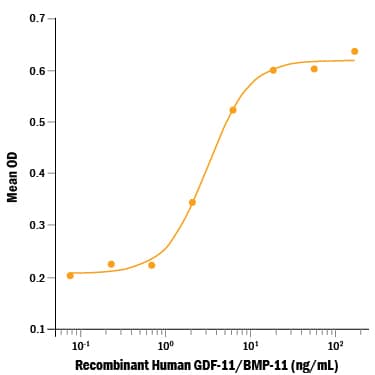Recombinant Human/Mouse/Rat GDF-11/BMP-11 Protein Best Seller
R&D Systems, part of Bio-Techne | Catalog # 1958-GD

Key Product Details
Source
Accession #
Structure / Form
Conjugate
Applications
Product Specifications
Source
Asn299-Ser407, with an N-terminal Met
Purity
Endotoxin Level
N-terminal Sequence Analysis
Predicted Molecular Mass
Activity
The ED50 for this effect is 0.8-4.8 ng/mL.
Scientific Data Images for Recombinant Human/Mouse/Rat GDF-11/BMP-11 Protein
Bioactivity of Recombinant GDF-11 Protein
Recombinant Human/Mouse/Rat GDF‑11 protein 1958-GD induces hemoglobin expression in the K562 human chronic myelogenous leukemia cell line. The ED50 for this effect is 0.8-4.8 ng/mL.Bioactivity of Recombinant GDF-11 Protein
1 μg/lane of Recombinant Human/Mouse/Rat GDF‑11 1958-GD protein was resolved with SDS-PAGE under reducing (R) and non-reducing (NR) conditions and visualized by silver staining, showing bands at 13 kDa and 21 kDa, respectively.Bioactivity of Recombinant GDF-11 Protein
ESI analysis of Recombinant Human/Mouse/Rat GDF-11 protein 1958-GD. The peak at 25163 Da corresponds to the calculated molecular mass of the disulfide-linked homodimer.Formulation, Preparation and Storage
Carrier Free
What does CF mean?CF stands for Carrier Free (CF). We typically add Bovine Serum Albumin (BSA) as a carrier protein to our recombinant proteins. Adding a carrier protein enhances protein stability, increases shelf-life, and allows the recombinant protein to be stored at a more dilute concentration. The carrier free version does not contain BSA.
What formulation is right for me?In general, we advise purchasing the recombinant protein with BSA for use in cell or tissue culture, or as an ELISA standard. In contrast, the carrier free protein is recommended for applications, in which the presence of BSA could interfere.
Carrier: 1958-GD
| Formulation | Lyophilized from a 0.2 μm filtered solution in Acetonitrile and TFA with BSA as a carrier protein. |
| Reconstitution | Reconstitute at 100-200 μg/mL in sterile 4 mM HCl. |
| Shipping | The product is shipped at ambient temperature. Upon receipt, store it immediately at the temperature recommended below. |
| Stability & Storage | Use a manual defrost freezer and avoid repeated freeze-thaw cycles.
|
Carrier Free: 1958-GD/CF
| Formulation | Lyophilized from a 0.2 μm filtered solution in Acetonitrile and TFA. |
| Reconstitution | Reconstitute at 100-200 μg/mL in sterile 4 mM HCl. |
| Shipping | The product is shipped at ambient temperature. Upon receipt, store it immediately at the temperature recommended below. |
| Stability & Storage | Use a manual defrost freezer and avoid repeated freeze-thaw cycles.
|
Background: GDF-11/BMP-11
References
- Gamer, L.W. et al. (1999) Dev. Biol. 208: 222.
- Nakashima, M. et al. (1999) Mech. Dev. 80:185.
- Gad, J.M. and P.P.L. Tam (1999) Curr. Biol. 9:R783.
- McPherron, A.C. et al. (1999) Nat. Genet. 22:260.
- Esquela, A.F. and S.J. Lee (2003) Dev. Biol. 257:356.
- Oh, S.P. et al. (2002) Genes & Dev. 16:274.
- Loffredo, F.S. et. al. (2013) Cell. 153.828.
- Katsimpardi, L. et. al. (2014) Science (ahead of print).
- Sinha, M. et. al. (2014) Science (ahead of print).
Long Name
Alternate Names
Entrez Gene IDs
Gene Symbol
UniProt
Additional GDF-11/BMP-11 Products
Product Documents for Recombinant Human/Mouse/Rat GDF-11/BMP-11 Protein
Product Specific Notices for Recombinant Human/Mouse/Rat GDF-11/BMP-11 Protein
For research use only


